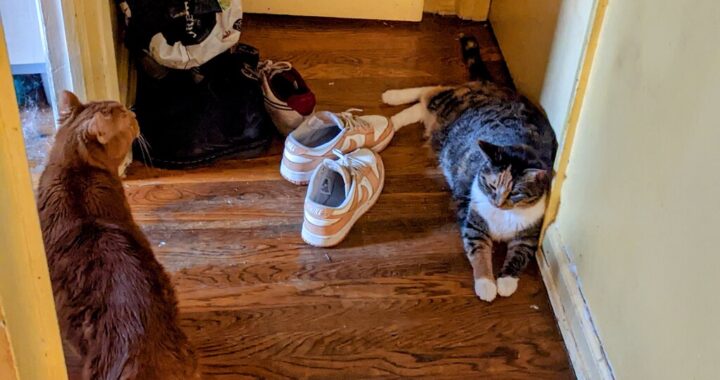
by Nomi Berger
Have you ever been in the position of finding a litter of kittens and wondering what to do next? To keep or not to keep, that is the question.
Here, then, are some answers — together with more questions.
- If you find a litter of kittens on or near your property, quickly assess their health. If they appear healthy, watch them, but don’t move them. Their mother is likely nearby. Stay far enough away – several car lengths – that you’re not considered a threat by their mother if she’s feral. If, however, the kittens seem distressed or are very vocal, and if their mother hasn’t returned by the end of the day, she may NOT be returning.
- Unless they’re in danger, however, it’s best to give their missing mother another chance to return and tend to them. Place them in a carrier or cardboard carton to keep them warm, safe and secure.
- Try to determine the age of the kittens. Are they newborns with their eyes closed and weighing less than 8 ounces? Or are they 8 weeks old, weighing 2 pounds, and resembling miniature cats? Not to mention every age and weight in between. Each age brings with it a different set of criteria as to their proper maintenance and care. If they’re newborns, contact local rescue groups or no-kill shelters ONLY that may be willing to take them in immediately.
- Are they feral (part of a colony of cats born to live and survive outdoors) or domestic kittens born to a family’s lost companion cat? Once again, this will determine the steps you take next.
- If it’s either too hot or too cold outside, raining or snowing, bring the kittens indoors and confine them to a clean, quiet and small room — whether a spare bedroom, bathroom or laundry room. Leave them in their carton or carrier with the door open, and provide them with a high-quality kibble, fresh water and cat litter. If the kittens are too young to feed themselves, you’ll need to bottle feed them every couple of hours. Should you choose this course, either contact a local vet or rescue group for advice and guidance.
- Within a few days, decide whether you want to temporarily foster them, bearing in mind that socializing them as quickly as possible will improve their chances of ultimately being adopted.
- Although adorable and impossible to resist, kittens do have little claws and sharp teeth. To protect yourself from unnecessary “battle scars”, wear gloves until the kittens grow comfortable with being handled.
- If you have other pets, keep them separated from the kittens to minimize the risk of their transmitting either parasites or infections to them.
- To make fostering the kittens easier, speak with the volunteers at the rescue group you’ve already contacted and ask for their advice – on all matters from A to Z.
- When it’s time for the kittens to “leave the nest”, either contact your vet, one who operates a re-homing center that will welcome yours if there’s room, or the rescue group. Relinquish the kittens into their care where they’ll be spay/neutered, then set on the right path towards finding their fur-ever homes.
By your actions, compassionate and caring, you’ll have not only saved several small lives, but you’ll have shared in an extraordinary experience, one you’re unlikely to ever forget.







